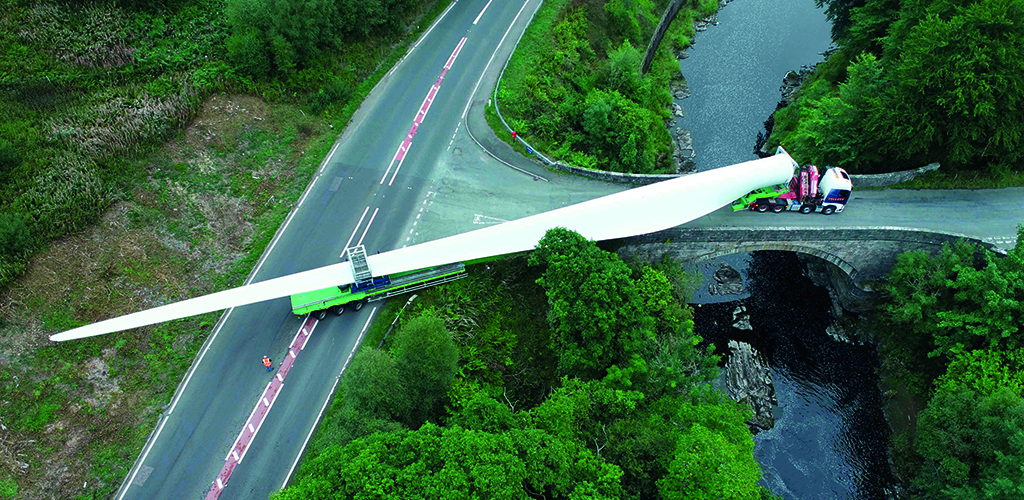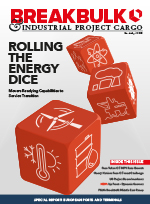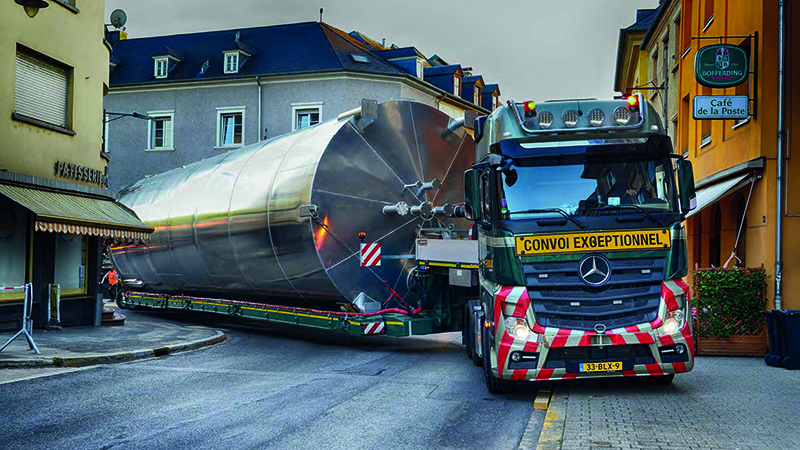Proposals to Shift More Project Cargo Onto Rail and Waterways

By Simon West
 The demand across Europe for project cargo haulers is rising, as the region’s post-lockdown economies gain momentum and industrial activity picks up.
The demand across Europe for project cargo haulers is rising, as the region’s post-lockdown economies gain momentum and industrial activity picks up.
Although the movement of heavy and abnormal loads accounts for just 2 percent of the total volume of cargo traffic on European roads, you would be hard-pressed to find any industry voice downplaying its crucial role.
 “If you do not have abnormal transport, you will build no wind farm park, you will build no power station, you will have no industry appliances built, you will get no construction machinery – because all of that is done with exceptional transport,” said Ton Klijn, director of the European Association of Abnormal Road Transport and Mobile Cranes, or ESTA.
“If you do not have abnormal transport, you will build no wind farm park, you will build no power station, you will have no industry appliances built, you will get no construction machinery – because all of that is done with exceptional transport,” said Ton Klijn, director of the European Association of Abnormal Road Transport and Mobile Cranes, or ESTA.
The industry though faces major challenges that need to be addressed to ensure it remains competitive, with some European countries looking to ease congestion, protect infrastructure and build on green transition efforts by shifting more project cargo onto rail and waterways.
In the UK, the longstanding Water Preferred policy aims to take slow-moving “abnormal, indivisible loads” weighing more than 150 tonnes off the road network, while in Germany, the government is mulling measures put forward by its transport and digital infrastructure ministry to use railways and canals for heavy cargo routes stretching more than 250 kilometers.
“The roads in Germany are overloaded and the bridges are becoming weaker and weaker,” said Thorge Clever, project manager at German heavy transport provider Kübler Spedition. “This inevitably leads to a shift to water and rail. At the hub in Mannheim (a key logistics center in southwest Germany and home to the country’s second-largest river port), the goods can easily be reloaded from road to water. The railroad is also beneficial for oversized cargo, although for large dimensions it becomes difficult.”
Challenges to Mode Shift
However, the use of trains and boats rather than trucks is not always feasible.
 Charlie Latham, head of tendering and business development at UK-based heavy transport specialist Allelys, said the British rail network was not designed to carry out-of-gauge cargo – a comment which could be applied to most national rail networks.
Charlie Latham, head of tendering and business development at UK-based heavy transport specialist Allelys, said the British rail network was not designed to carry out-of-gauge cargo – a comment which could be applied to most national rail networks.
“The inland waterways are also extremely limited and while some sections of the main heavy-lift routes have access, the majority do not,” Latham said. “Those with access are usually only for part of the route and would require road transport to complete the journey, therefore introducing further costs than by completing the whole route by road.”
The company follows the Water Preferred policy by moving heavy cargo along coastal sea routes where possible, although roads still provide the advantage, Latham said.
“The roads have greater capacity than alternative options and with cargo continuing to increase in size and weight, this extra capacity is often required. The specialist equipment used for this type of cargo is also designed to be used on the roads.”
Klijn meanwhile estimated that 90 percent of abnormal loads in Europe are too large to fit through train tunnels, while switching to waterways could double or even triple costs for project cargo owners.
“What you do is put something on a trailer, you drive it to a quayside, you get a big crane, you get your heavy load into a ship, it sails to wherever you want to go, or the vicinity of wherever you want to go, then you get another big crane, lift it out again, put it on the trailer, and you drive to where to want to go and offload it,” Klijn said.
“This could have been avoided by just leaving it on the trailer in the first place and driving on the roads to where you want to go.”
Pandemic Alters Access
During the pandemic, as border closures hampered global cargo movements and lockdowns caused supply chain chaos, inland transportation in Europe faced some unique challenges.
 The European Commission, under pressure from the International Road Transport Union, or IRU, tried to keep freight moving across the euro zone by offering guidance to its member states on setting up “green lanes” – border crossings located along the trans-European transport network, or TEN-T, that would limit cargo processing time to 15 minutes.
The European Commission, under pressure from the International Road Transport Union, or IRU, tried to keep freight moving across the euro zone by offering guidance to its member states on setting up “green lanes” – border crossings located along the trans-European transport network, or TEN-T, that would limit cargo processing time to 15 minutes.
Further EU measures were adopted to keep cargo moving, including a directive in January this year recognizing transport workers and seafarers as “travelers with an essential function or need.”
Still, Covid tested the resolve of haulage drivers, with restrictions often creating intolerable working conditions. Some 3 percent to 4 percent of drivers left the profession during the pandemic, Klijn said.
“Drivers that go to loading or unloading places traditionally get the chance to use a decent toilet or to use a canteen facility,” the ESTA director said.
“The first thing the shippers did was ban drivers from entering their premises. There were even places where they were not allowed to leave their cabins when they were unloading their trucks. This of course does not make the profession any better for people to be in.”
As pandemic restrictions have eased, other challenges have begun to emerge.
Changes to permitting rules for heavy transport, for example, are generating concern and frustration among European heavy haulers.
In Germany, an overhaul of the so-called Vemags online system for the application and approval for large-scale and heavy transport took effect in January 2021 as authorities sought to harmonize permit procedures and rates across the country’s 16 federal states.
Under the new rules, international companies can only apply for a transport permit at the place at which they cross the border into Germany, while German-based firms can lodge their request from three separate locations, including their company premises.
Detractors claim the new system gives German haulers an advantage over their European counterparts, and has led to delays, red tape and costs that could end up rising by up to 130 percent, ESTA said.
German authorities said the changes were also needed to tackle “permit tourism” whereby companies attempt to jump the queue by lodging applications with several different authorities to see which one processes their request the fastest.
“The official comment when we complained to the German authorities that this was competition fraud was ‘no, because we are going to expand the capacity at the border places so much and there will not be any time difference in the issue of the permit,’ ” said Klijn.
“The opposite is the case – the permit times are going through the roof so sometimes it takes eight weeks or three months to get a permit.”
The reforms have gone down badly even with German operators.
“Unfortunately, the new Vemags system is not very flexible, and there are many limitations for users. We sense that the procedures are becoming increasingly difficult,” Clever said.
Drivers Needed
Another concern for specialist transport firms is driver shortages.
In the UK, Covid-19 complications have been compounded by Brexit.
“It is fair to say that the UK as a whole has experienced driver shortages within the last 12 months,” Allelys’ Latham said.
 “Lockdown measures meant that Heavy Goods Vehicle driver tests were unavailable or limited, so the number of new drivers entering the job market was significantly lower than normal. The UK’s immigration rules also changed with Brexit, affecting the flexibility that European drivers had previously.
“Lockdown measures meant that Heavy Goods Vehicle driver tests were unavailable or limited, so the number of new drivers entering the job market was significantly lower than normal. The UK’s immigration rules also changed with Brexit, affecting the flexibility that European drivers had previously.
“Having said that, the heavy-lift and transport sector offers drivers a unique opportunity to move specialist cargo. It is a role that continues to attract candidates, which has minimized the impact of the driver shortage.”
Luring talent from a more diverse pool of workers would be one way to guarantee the sustainability of the industry and ensure heavy haulers have a well-trained workforce to call on.
For ESTA, improving working conditions for drivers is crucial.
The association has been campaigning to improve the scope and safety of facilities catering to long-distance heavy-haul drivers throughout the EU, a move that would help resolve longstanding recruitment problems by encouraging younger drivers and more women drivers to join the industry.
The European Commission has announced plans to develop a network of Safe and Secure Truck Parking Areas, or SSTPAs, every 100 kilometers along the TEN-T.
According to the IRU, the EU has a shortfall of some 100,000 truck parking spaces to meet total demand, with less than 3 percent of the region’s 300,000 existing parking spaces in certified safe and secure areas.
“There is a huge deficit of safe truck parking areas throughout Europe,” Klijn said.
“With abnormal transport, you do not only have to abide by the normal driving and rest time rules, but in addition to this, you also have permitting rules that only allow you to drive during certain hours or require you to stop during other certain hours, which means the need for a good stop place for abnormal transport is even higher than for a normal truck.
“We are battling to make sure we get these places set up along the network.”
Colombia-based Simon West is senior reporter for Breakbulk.
Photo 1: With cargo continuing to increase in sizeand weight, roads have greater capacitythan alternative options.CREDIT: COLLETT & SONS
Photo 2: Tom Klijn, director, European Association of Abnormal Road Transport and Mobile Cranes, or ESTA.
Photo 3: Charlie Latham, head of tendering and business development, Alleys
Photo 4: ESTA is campaigning for improved working conditions for heavy-haul drivers.CREDIT: ALLELYS
Photo 5: The European Commission tried to keep heavy freight moving throughout the pandemic.CREDIT: BOLK TRANSPORT
